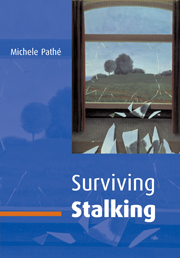Book contents
- Frontmatter
- Contents
- Acknowledgments
- Introduction
- 1 What is stalking?
- 2 How common is stalking?
- 3 Who stalks?
- 4 Could I be assaulted?
- 5 Can stalkers be treated?
- 6 Who are the victims of stalking?
- 7 The impact of stalking
- 8 Reducing your chances of victimization
- 9 Evading the stalker
- 10 Navigating the criminal justice system in the United States of America
- 11 Navigating the criminal justice system in the United Kingdom
- 12 Navigating the criminal justice system in Australia
- 13 Should I just disappear?
- 14 How do I deal with the emotional impact of stalking?
- 15 How you can assist victims of stalking
- Conclusions
- References
- Reading guide
- Appendix 1 Other resources
- Appendix 2 Protection from Harassment Act 1997
- Appendix 3 Sample restraining order under Protection from Harassment Act 1997
- Appendix 4 Criminal justice system flow chart, UK
- Index
11 - Navigating the criminal justice system in the United Kingdom
Published online by Cambridge University Press: 04 September 2009
- Frontmatter
- Contents
- Acknowledgments
- Introduction
- 1 What is stalking?
- 2 How common is stalking?
- 3 Who stalks?
- 4 Could I be assaulted?
- 5 Can stalkers be treated?
- 6 Who are the victims of stalking?
- 7 The impact of stalking
- 8 Reducing your chances of victimization
- 9 Evading the stalker
- 10 Navigating the criminal justice system in the United States of America
- 11 Navigating the criminal justice system in the United Kingdom
- 12 Navigating the criminal justice system in Australia
- 13 Should I just disappear?
- 14 How do I deal with the emotional impact of stalking?
- 15 How you can assist victims of stalking
- Conclusions
- References
- Reading guide
- Appendix 1 Other resources
- Appendix 2 Protection from Harassment Act 1997
- Appendix 3 Sample restraining order under Protection from Harassment Act 1997
- Appendix 4 Criminal justice system flow chart, UK
- Index
Summary
The Protection from Harassment Act 1997 (referred to throughout this chapter as the Act) was introduced ‘in order to protect persons from harassment and similar conduct’. This chapter describes the new Act and explains how it might be used by stalking victims. The chapter also sets out the process entailed for victims who are considering involving the police and the courts and what might happen at each stage. This is summarized in the flow diagram in Appendix 4.
There is purposefully no legal definition of stalking or harassment in the UK Act. It was thought that if harassment had been defined, then some stalkers might adapt their behaviour to ensure that it remains within the law. To avoid this trap, the Act aims to prohibit all behaviour that has a particular effect on you, and it is the effect that the harassment has on you which has been defined. In this way, the pitfalls and loopholes observed with many of the earlier laws in other jurisdictions throughout the world have been avoided.
The extent of stalking in the UK
When the Act was introduced, although there was considerable public concern regarding stalking, there were no population based studies from the UK exploring the extent of stalking. However, there were indications from the United States and Australia that it might be a widespread problem.
- Type
- Chapter
- Information
- Surviving Stalking , pp. 91 - 106Publisher: Cambridge University PressPrint publication year: 2002



